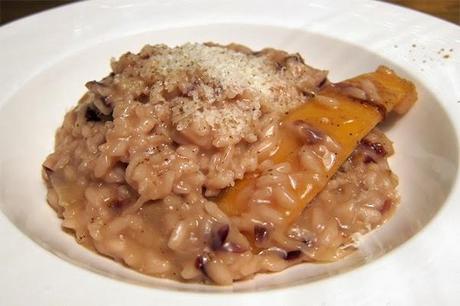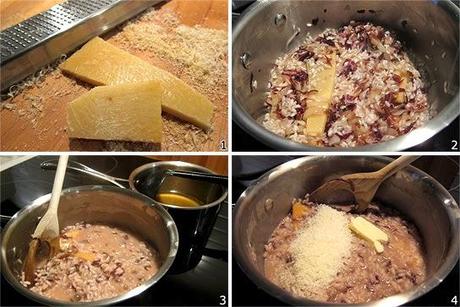
Part of the spirit of Cucina Povera (the Cuisine of the Poor) is frugality and eating anything that can still be eaten. For some ingredients, this even involves a special preparation or a process to make them more edible. And this is certainly the case with Parmesan rind, which is safe to eat, but too hard to be chewed.
I grew up in one of those northern Italian families that go through a lot of Parmesan! It's almost always sprinkled over pasta dishes and an essential component of risotto. Because of this, in our fridge, in the cheese drawer, there were always a couple of pieces of Parmesan rind which were saved for the next risotto. Parmesan rind can also be used to flavor soups, but in my family we never used it that way.
For the use in risotto, the rind is added at the beginning of the preparation. As the stock is gradually incorporated, the rind releases flavor, while re-hydrating itself and becoming softer. When using a relatively young Parmigiano Reggiano or Grana Padano (a different cheese, similar in flavor, but aged less), by the time the risotto is cooked, the rind will appear substantially thinned, and will be easy to cut with a knife or even the side of a fork. Although it might be an acquired taste for some, the rind will be absolutely delicious when eaten in small bites, along with the risotto. When using particularly aged Parmigiano Reggiano, instead, the rind will still be quite hard at the end of the cooking - if not chewable, of course, it should be discarded (in this case, the rind will be only used as flavoring).
Parmesan rind can be added to all kinds of risotto, but in the case of a radicchio risotto it is even more desirable. Radicchio, a vegetable that belongs to the chicory family, has a bitter flavor which is especially pronounced when raw, but also present when cooked. Any bitterness can be dampened by adding some saltiness. Because of this, Parmesan is a great pairing for radicchio. Some people, however, develop tolerance or even a liking for the bitterness of radicchio. If its bitterness is not a problem, thinly sliced fresh radicchio can be added to the finished risotto as a garnish.
Ingredients for 2 servings
- ⅔ cup of Carnaroli rice
- 3 cups of vegetable or beef stock
- 1 shallot, chopped
- ½ radicchio, thinly sliced
- 1 tablespoon of unsalted butter
- 1 glass of white wine (red can also be used for a stronger flavor and for color)
- ¼ cup of Parmesan, grated
- 1 or 2 Parmesan rinds, scraped and washed
- Some ground black pepper
Preparation

- Bring the stock to a gentle boil in its own saucer.
- Prepare the Parmesan rinds by scraping off the top of the rind, the part that would have been directly exposed to the air (fig. 1).
- In a second, larger, saucer, sauté the onion in 2/3 of the butter until translucent, then add the radicchio and continue cooking at medium heat until softened.
- Add the rice and stir at medium heat for a couple of minutes.
- Add the wine and the Parmesan rind (fig. 2). Set the timer: the risotto will be cooked in 18 minutes.
- Keep stirring. When the rice dries out a bit, add some stock and go back to stirring (fig.3).
- When the time is up, turn off the heat, add 2/3 the grated Parmesan and the remaining butter (fig. 4). Keep stirring for 1 more minute.
- Serve in bowls sprinkled with the rest of the grated Parmesan, some ground black pepper and (optionally) garnished with fresh thinly-sliced radicchio (see picture below).

If the bitterness of radicchio is appreciated,
fresh radicchio can be added as a garnish.

